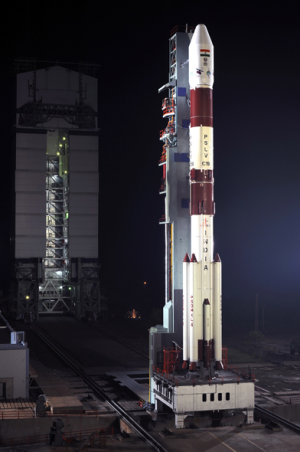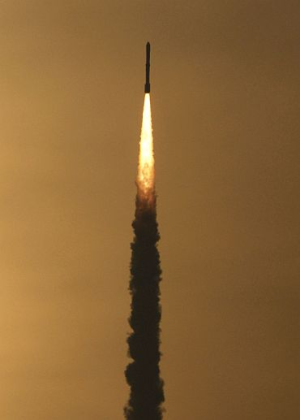Coverage by TheHindu back in 2012 (the web URL to the article no longer works):
India's space and security capabilities are poised for a big leap with the launch of an entirely indigenous radar imaging satellite, RISAT-1.
In the popular mind, radar satellites have a swashbuckling image that is often associated with covertly watching over other countries and tracking their military hardware. These satellites can certainly serve that sort of function. But such spacecraft also support a range of more humdrum but vital operations.
Optical satellites rely on sunlight to illuminate the ground below, working much like an ordinary camera does. Radar satellites, on the other hand, must send out pulses of radio waves and then pick up signals that bounce back.
Click here for PDF
Once the monsoon sets in over India, cloud cover often severely limits the useful images that satellites with optical cameras can supply. But radar can see through cloud and rain. Nor does darkness hamper its operation.
Optical or radar?
The Indian Space Research Organisation (ISRO) has long been aware of the advantages of deploying radar in space, remarked Y.S. Rajan, who was its Scientific Secretary for many years from the late 1970s and participated in the decision-making process that shaped the remote sensing programme.
The engineering challenges of putting a radar on a satellite are "enormous" and considerably greater than for building optical imaging satellites, he told The Hindu. The processing of radar data and interpretation of images are also vastly more complicated. In addition, there was pressure from the launch vehicle team to hold down the weight of satellites, a factor that again worked in favour of optical satellites.
So while ISRO opted to go the optical route for India's early remote sensing satellites, it was also very clear that the technological capability to build and use space-based radars needed to be developed, he said. Led by O.P.N. Calla, a group at ISRO's Space Applications Centre at Ahmedabad built a "Side-Looking Airborne Radar" that was installed on a Dakota aircraft in 1980. It subsequently built a more sophisticated "Airborne Synthetic Aperture Radar." The National Remote Sensing Centre at Hyderabad operates two aircraft that can carry such radars.
Apart from learning to build the hardware, the space agency sought to develop the necessary expertise in using radar imageries for various applications. It did so by taking data from foreign radar satellites, starting with Europe's ERS-1 that was launched in 1991.
Flood mapping, agriculture
Satellite radar data, often from Canada's RADARSAT satellites, is now routinely used during the monsoon to provide near real time flood mapping. In last year's monsoon, for instance, radar data was drawn upon to identify affected areas when floods struck Assam, West Bengal, Orissa, Uttar Pradesh and Kerala.
Monitoring crops from space to derive timely and more accurate estimates of acreage and yield was identified as an important application early on in India's remote sensing programme. But with small field sizes in the country, different crops being grown in the same area and variations in agricultural practices, establishing 'signatures' that can distinguish one crop from another has been difficult enough with optical remote sensing.
It becomes even more complicated with radar where a number of factors, such as soil characteristics, moisture levels in the soil and even the plant size and shape, influence the signals that return to the satellite.
Radar, however, opens up the possibility of monitoring crops grown during the monsoon when extensive cloud cover often hinders optical satellites. Data from Canada's RADARSAT satellites is currently being used for operational rice crop inventory at the state and national levels, according to a journal paper published by a team of ISRO scientists. There has also been some success with jute.
RADARSAT data was costly, remarked one person who was involved with the Indian remote sensing programme. "With our own satellite, we will be able to carry out more extensive studies for establishing ways to monitor other crops with the required accuracy."
Glacier study
Satellite-borne radar could prove useful in studying glaciers in the Himalayas, according to Anil V. Kulkarni who earlier worked at the Space Applications Centre and is now with the Divecha Centre for Climate Change at the Indian Institute of Science in Bangalore.
Radar techniques could potentially be employed to understand some key parameters of glaciers, including their rate of movement and area. It may also be possible to derive indications of whether they are gaining or losing mass from one year to the next. Such information could provide important insights into how climate change is affecting the glaciers.
Radar data could also be utilised to figure out how much snow was melting in summer. With suitable modelling, it should then be possible to estimate the run-off that flows into various rivers, he pointed out.
RISAT-1's radar data is likely to find many more applications, including in geology, terrain mapping and forestry. Oceanography can benefit from information on winds and currents that such data can supply. Canada is reportedly using its RADARSAT satellites to manage shipping operations, including monitoring offshore fishing activities.
After the 2010 Deepwater Horizon oil spill in the Gulf of Mexico, data from a number of radar satellites was used to keep a careful eye on the spread of the resulting oil slick.
Military use
A radar satellite opens up avenues for watching over another country's military operations. Such satellites can pick out military vehicles, aircraft and ships.
A radar satellite is "a very powerful instrument" for detecting naval movements, remarked Bhupendra Jasani of the Department of War Studies at King's College London. They could even pick up the wake of submarines moving below the surface.
Prof. Jasani has worked extensively on using commercially available satellite imagery as a way of verifying compliance with arms control and other international treaties.
Radar imageries could also aid in examining if a nuclear reactor was being used for plutonium production. In that case, there would be signs that the reactor was being shut down more frequently, he told this correspondent.
For India, the ability to design, build and utilise radar satellites therefore represents a quantum jump in its remote sensing capabilities both for civilian and security-related applications. More radar satellites will doubtless follow RISAT-1.




